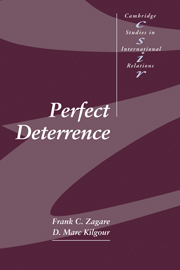Book contents
- Frontmatter
- Contents
- List of figures
- List of tables
- Preface
- Part I Theoretical underpinnings
- 1 Classical deterrence theory
- 2 Rationality and deterrence
- 3 Credibility and deterrence
- Part II Direct deterrence
- Part III Extended deterrence
- Part IV Implications
- Appendices
- 1 Deterrence models
- References
- Index
- CAMBRIDGE STUDIES IN INTERNATIONAL RELATIONS
3 - Credibility and deterrence
Published online by Cambridge University Press: 01 October 2009
- Frontmatter
- Contents
- List of figures
- List of tables
- Preface
- Part I Theoretical underpinnings
- 1 Classical deterrence theory
- 2 Rationality and deterrence
- 3 Credibility and deterrence
- Part II Direct deterrence
- Part III Extended deterrence
- Part IV Implications
- Appendices
- 1 Deterrence models
- References
- Index
- CAMBRIDGE STUDIES IN INTERNATIONAL RELATIONS
Summary
A rational deterrent cannot be based on irrational responses.
Richard NixonThe fundamental tenets of classical deterrence theory are incompatible with models based on rational choice. Deterministic threats, which rest on the presumption that states can commit themselves to irrational actions, violate the canons of both classical deterrence theory and instrumental rationality. While the threat-that-leaves-something-to-chance maintains consistency with the rationality postulate, consistency is achieved only by assuming that irrational actions are carried out by a disinterested third party. And the resolution suggested by a metagame analysis serves merely to bring the paradox of mutual deterrence into sharper focus: when the costs of war are so high that all-out conflict is the worst outcome for both players, mutual deterrence is unlikely. It might appear, then, that there is no escape from this pernicious puzzle.
We believe otherwise. In this chapter we propose still another resolution. Our proposal is based on the concept of perfectly credible retaliatory threats. Like other attempts to eliminate the paradox, this resolution involves a modification of the underlying game form; but unlike other proposals, ours retains the core realist assumption of an anarchical international system while remaining faithful to the definition of instrumental rationality. In a narrow technical sense, then, the paradox of mutual deterrence stands. Technicalities aside, however, the resolution we propose permits an intuitively satisfying and empirically plausible respecification of classical deterrence theory that helps to explain the dynamics of a wide range of deterrence relationships, including those that occur under the conditions that delimit the paradox.
- Type
- Chapter
- Information
- Perfect Deterrence , pp. 65 - 96Publisher: Cambridge University PressPrint publication year: 2000



